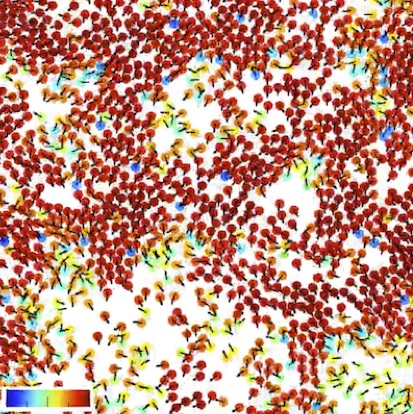 |
Our walking grains were designed from 2008, during the thesis of Julien Deseigne. These are 4mm or 6mm diameter metal discs with an eccentric tip and a rubber pad bonded diametrically opposite to the tip. The discs are placed on a vibrating plate. These two "legs" have a different mechanical response and give the particles a polar axis. Under vibration, the disks perform a persistent random walk, whose persistence length is adjusted by the vibration parameters. We also use isotropic discs, whose contact with the plate is a metallic cylinder, as inactive particles of references. Deseigne, J., Dauchot, O., & Chaté, H. (2010). Collective Motion of Vibrated Polar Disks. Physical Review Letters, 105(9).1 |
 |
For an optimum vibration, such that the length of persistence is as large as possible, of the order of 10 disc diameters, and beyond a surface fraction of the order of 30 to 40%, an assembly of walking grains present remarkable collective motion. They form clusters of aligned particle, animated by a coherent motion, while no attractive force nor alignment is a priori present at the level of the pair interaction. At higher packing fraction, collective motion in the form of alternate vortices takes place. Deseigne, J., Léonard, S., Dauchot, O., & Chaté, H. (2012). Vibrated polar disks: spontaneous motion, binary collisions, and collective dynamics. Soft Matter, 8, 5629. |
 |
We have reproduced these effects numerically and confirmed that in the presence of periodic boundary conditions, an overall collective polar motion develops, the vast majority of the grains all going in the same direction ... A theoretical analysis based on the Boltzmann equation allowed us to quantitatively understand the transition and develop a physical intuition of the types of transition towards collective motion depending on to the nature of the effective alignment properties between the pair of particles. Weber, C. A., Hanke, T., Deseigne, J., Léonard, S., Dauchot, O., Frey, E., & Chaté, H. (2013). Long-Range Ordering of Vibrated Polar Disks. Physical Review Letters, 110(20), 208001. Lam, K.-D. N. T., Schindler, M., & Dauchot, O. (2015). Self-propelled hard disks: implicit alignment and transition to collective motion. New Journal of Physics, 17(11), 113056. |
 |
What about even higher packing fraction? The two-dimensional crystallization of hard disks at equilibrium follows a very specific transition scenario (the characterization of which, among other things, motivated the award of the Nobel Prize for Physics 2016 to Michael Kosterlitz , David Thouless, and T Duncan Haldane). We have shown that for our system of active disks, the crystallization scenario and the crystal phase itself are radically different. The quasi-continuous transition of equilibrium is replaced by a large crossover where very dense clusters of all sizes coexist with a very dilute phase. In the "crystalline" phase, where a large majority of the particles form crystalline clusters, the dynamics remain exceptionally rapid. The active crystal actually melts permanently ... Briand, G., & Dauchot, O. (2016). Crystallization of Self-Propelled Hard Discs. Prl, 117(9), 098004–5. |


